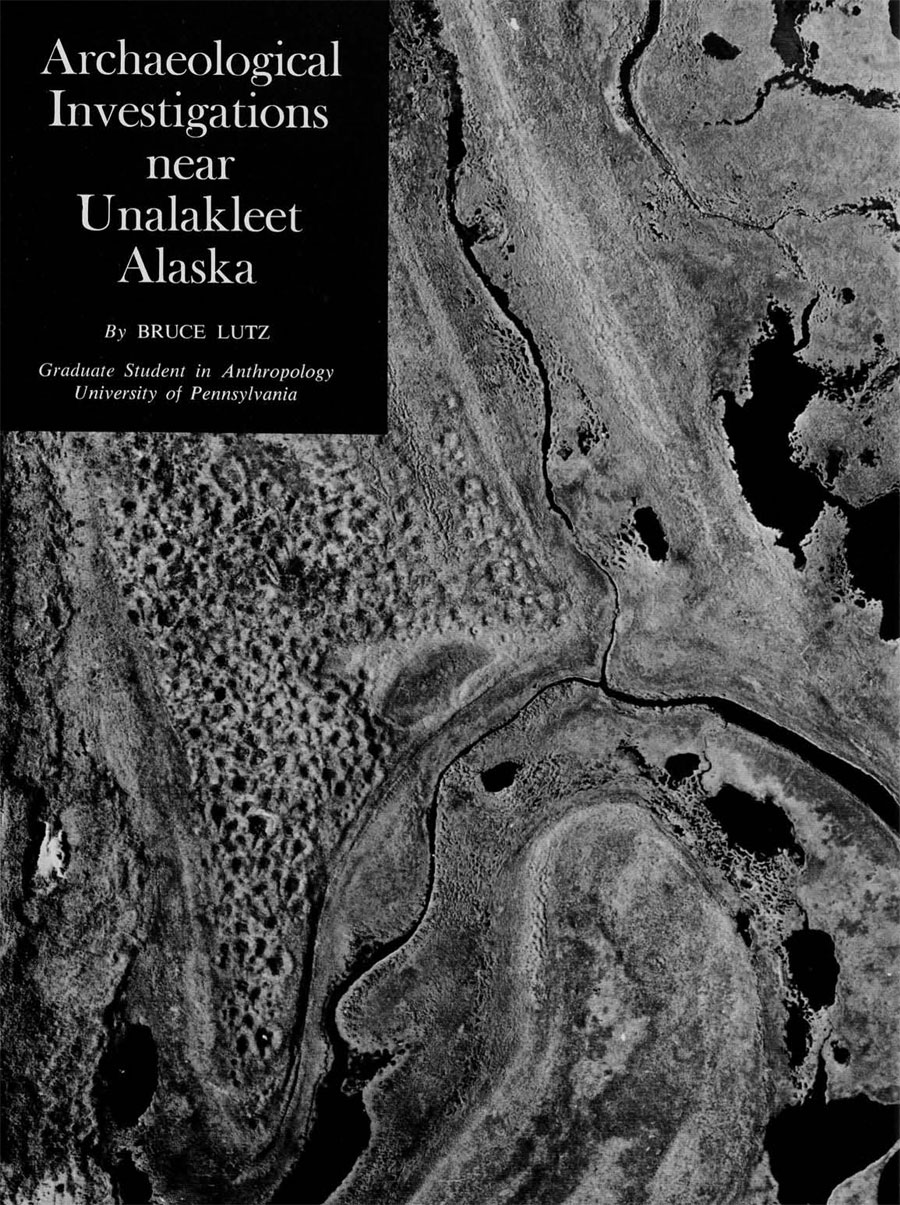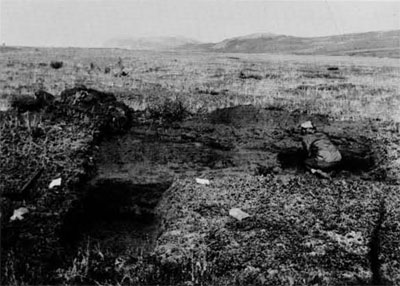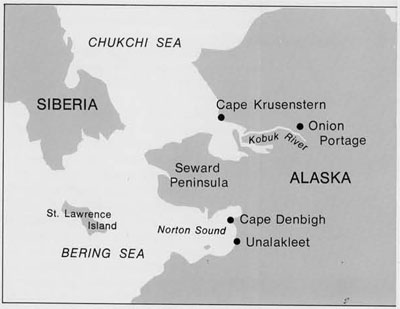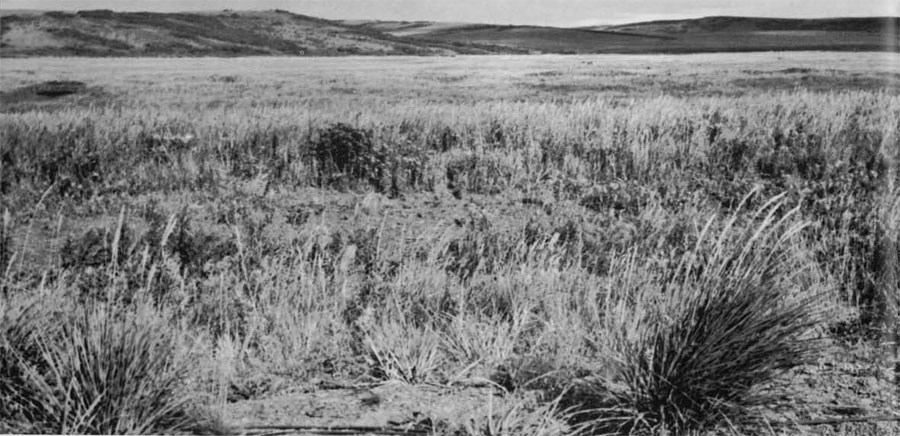
Preliminary excavations were begun near the village of Unalakleet on the coast of Norton Sound this past summer. Several of the villagers told me that they can remember that the spit upon which the present village is built was in former times much narrower than it is today. The process of the land gradually encroaching upon the sea is also recorded archaeologically, for the present village is situated on the most modern beach ridge. The archaeological site, however, is on an older beach ridge and is now approximately a quarter mile from the shoreline. The two to three hundred house pits which comprise the site cover several acres.


From the surface the house pits show a wide range of form. The majority are round or oval in shape and are usually about five feet deep. The size of these round or oval depressions varies widely, their diameter ranging from ten to over twenty feet. In addition, there are also square and rectangular house pits. These are usually shallower than the round pits, being only about two feet deep. Their size varies considerably, some being only about ten feet on a side while others measure more than thirty-three feet.
A small semi-subterranean house, about ten feet on a side, was fully excavated. It is approximately in the shape of a square whose entrance faces Norton Sound, and whose hearth is in the center of the floor. Though no wood was recovered, trough-like depressions completely outlined the house, making it probable that it was bordered by logs. Probable post holes were observed in two of the four corners of this house. The artifacts recovered include side blades, flake knives, and check-stamped pottery, and are similar to those found at Cape Denbigh by Giddings between 1948 and 1952 and belonging to a period which he called “Norton.” The size and shape of this house also parallel the Norton house excavated at Cape Denbigh.
Also excavated was a house which before digging appeared as an oval depression about ten feet long by six feet wide. It was at first thought that its floor, like that of the house previously described, lay near the surface. Such did not turn out to be the case, for this floor lay about five feet below the surface. Between it and the surface lay many levels of cultural debris which were probably formed in part after the house had collapsed. It is likely that the people who lived in the surrounding houses threw some of their debris into this pit. Interspersed with the cultural debris were lenses of gravel which had probably been thrown up by the sea during violent storms. During the last few years the modern village had to be evacuated during one of these storms. this house was bounded on one side by a complete log. The other sides had only fragments of log remaining.
Most of the artifacts recovered from this house resemble those of Cape Denbigh, and include side blades, end blades, net sinkers, and check-stamped pottery. However, on one of the strata above the floor a number of unusual artifacts were found in association with a burnt level. These artifacts are quite large and consist of both polished and unpolished jade or green-stone adzes, scrapers, and choppers. A large slate knife, about seven inches in length, was found associated with these objects. Scrapers recovered from all levels within this house also differ significantly from those of Cape Denbigh, those from Cape Denbigh being discoidal while these are nearly all ovoid.
Small test pits in two other houses deserve particular mention. The first of these houses showed on the surface as a twenty by twenty-seven foot rectangle, about five feet deep, and had a tunnel facing toward the south. Two projectile points found in the test pit were broad leaf-shaped forms rather than the typical asymmetrical side blades characteristic of the Norton period. However, the pottery in no way differs from Norton plain ware.
The second house in which a test pit only was excavated was a shallow rectangular depression of twenty-four by forty feet. Unlike the material from the houses described above, pottery and Norton-type side blades were completely absent. The projectile points, instead, were narrow and lance-like. Obsidian chips and artifacts were common, whereas in the other houses obsidian chips were rare, and not a single obsidian artifact was found. While future excavation of this house might alter the artifact inventory it seems at the present that the tool-making tradition exhibited here differs from that of the other houses.
The Norton cultural tradition had a wide area of dispersal within Alaska. At Chagvan Bay in southwestern Alaska, Larsen found Norton material, including the characteristic check-stamped pottery. Most of the excavations which have uncovered Norton occupation sites are in areas which are to the north of Unalakleet. Among such northern sites are Cape Krusenstern, Onion Portage, and the type site of Cape Denbigh.

The internal chronology of the Norton culture in the northern part of Alaska is provided by Giddings’ excavations at Cape Krusenstern, where nine beach ridges, covering the period from approximately 600 to 100 B.C. were occupied by peoples of the Norton cultural tradition. However, the origins of the Norton culture cannot be ascertained in the north.
In the southern and central parts of Alaska, in spite of the excavations at Cape Denbigh and Chagvan Bay, little is known of the internal developments within the Norton period. Nor, as is the case in the north, is anything known concerning the origins of the Norton tradition. Therefore, the site near Unalakleet, where there appears to be a long period of occupation during which there were changes in both house and artifact forms, is important. It is hoped that future excavation at this site will give us an understanding of cultural developments from the time of the Denbigh Flint Complex to Western Thule, as we observe both the origins and the internal development of the Norton culture.
